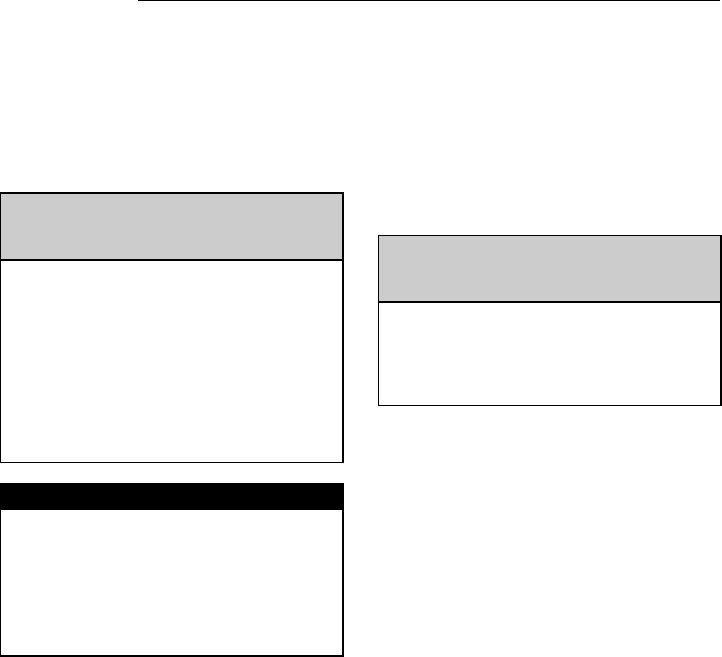
2
CORROSIVE CHEMICALS
Corrosive chemicals can also attack the module and gas
control and eventually cause a failure. Where chemicals
may be used routinely for cleaning, make sure the cleaning
solution cannot reach the controls. Where chemicals are
likely to be suspended in air, as in some industrial and
agricultural applications, protect the ignition module from
exposure with a NEMA 4 enclosure; see the Electronic
Ignition Service Manual, form 70-6604.
DUST OR GREASE ACCUMULATION
Heavy accumulation of dust or grease may cause the
controls to malfunction. Where dust or grease may be a
problem, provide covers for the module and the gas control
that will limit environmental contamination. A NEMA 4
enclosure is recommended for the ignition module; see the
Electronic Ignition Service Manual, form 70-6604.
HEAT
The controls can be damaged by excessively high
temperatures. Make sure the maximum ambient tempera-
ture at the control locations will not exceed the rating of the
control. If the appliance normally operates at very high
temperatures, insulation, shielding, and air circulation may
be necessary to protect the controls. Proper insulation or
shielding should be provided by the appliance manufac-
turer; make sure adequate air circulation is maintained
when the appliance is installed.
INSTALLATION
WHEN INSTALLING THIS IGNITION SYSTEM…
1.Read these instructions carefully. Failure to follow
them could damage the components or cause a hazardous
condition.
2.Check the ratings given in the instructions and on the
components to make sure they are suitable for your appli-
cation.
3.Installer must be a trained, experienced service tech-
nician.
4.After installation is complete, check out component
operation as provided in these instructions.
WARNING
FIRE OR EXPLOSION HAZARD.
CAN CAUSE SERIOUS INJURY OR DEATH.
1. The ignition module can malfunction if it gets
wet, leading to accumulation of explosive gas.
• Never install where water can flood, drip or
condense on module.
• Never try to use a module that has been
wet—replace it.
2. Liquefied petroleum (LP) gas is heavier than
air and will not vent upward naturally.
• Do not light pilot or operate electric
switches, lights, or appliances until you are
sure the appliance area is free of gas.
CAUTION
1. Disconnect power supply before beginning wiring
to prevent electrical shock or equipment damage.
2. If a new gas control is to be installed, turn off gas
supply before starting installation. Conduct Gas
Leak Test according to gas control manufac-
turer’s instructions after the gas control is in-
stalled.
3. If module must be mounted near moisture or
water, provide suitable waterproof enclosure.
PERFORM PREINSTALLATION SAFETY INSPECTION
The preinstallation checks described in ANSI Standard
Z21.71 on page 19
must
be done before the replacement
module is installed. If a condition which could result in
unsafe operation is detected, the appliance should be shut
off and the owner advised of the unsafe condition. Any
potentially unsafe condition must be corrected before pro-
ceeding with the installation.
Maintenance Requirements in Severe Environments
Regular preventive maintenance is important in any
application, but especially so in commercial cooking, agri-
cultural, and industrial applications because:
• In many such applications, particularly commercial
cooking, the equipment operates 100,000-200,000
cycles per year. Such heavy cycling can wear out the
gas control in one to two years. A normal forced air
furnace, for which the controls were originally in-
tended, typically operates less than 20,000 cycles
per year.
• Exposure to water, dirt, chemicals, and heat can
damage the module or the gas control and shut down
the control system. A NEMA 4 enclosure can reduce
exposure to environmental contaminants. See Elec-
tronic Ignition Service Manual, form 70-6604.
The maintenance program should include regular check-
out of the system as outlined under Checkout, page 11.
WARNING
FIRE OR EXPLOSION HAZARD
MAY CAUSE PROPERTY DAMAGE, SEVERE
INJURY OR DEATH
Do not attempt to take the module apart or to clean
it. Improper reassembly and cleaning may cause
unreliable operation.
Maintenance frequency must be determined individually
for each application. Some considerations are:
•
Cycling frequency
. Appliances that may cycle more
than 20,000 times annually should be checked
monthly.
•
Intermittent use
. Appliances that are used seasonally
should be checked before shutdown and again be-
fore the next use.
•
Consequence of unexpected shutdown
. Where the
cost of an unexpected shutdown would be high, the
system should be checked more often.
•
Dusty, wet, or corrosive environment.
Since these
environments can cause the controls to deteriorate
more rapidly, the system should be checked more
often.
Any control should be replaced if it does not perform
properly on checkout or troubleshooting. In addition, re-
place any module if it is wet or looks like it has ever been
wet. Protective enclosures as outlined under “Planning the
Installation” are recommended regardless of checkout fre-
quency.
MOUNT IGNITION MODULE
Select a location close enough to the burner to allow a
short (3 ft. [0.9 m] max.), direct cable route to the igniter.
Ambient temperature at the module must be within the
range listed under APPLICATION, page 1. The module
must be protected from water, moisture, corrosive chemi-
cals and excessive dust and grease.


















